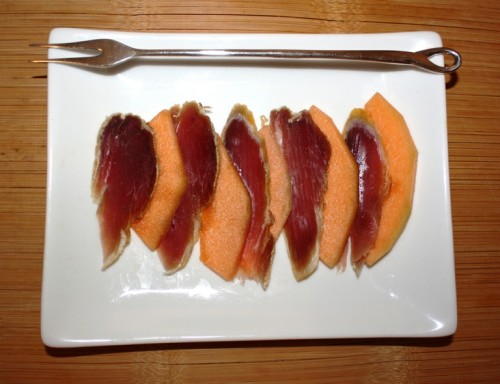 [1]Though you've often heard me rail against food-fads I confess I too have feet of clay. The siren song of the abattoir compounded by sibling rivalry instigated by my brother Kevin's Christmas triumph of home-cured and smoked bacon, grilled over hot colds in thick, sizzling slices was too much to bear. There was no stopping my leap into the home-curing craze with this recipe for homemade lonza [2], a traditional Italian cured pork loin or butt.
[1]Though you've often heard me rail against food-fads I confess I too have feet of clay. The siren song of the abattoir compounded by sibling rivalry instigated by my brother Kevin's Christmas triumph of home-cured and smoked bacon, grilled over hot colds in thick, sizzling slices was too much to bear. There was no stopping my leap into the home-curing craze with this recipe for homemade lonza [2], a traditional Italian cured pork loin or butt.
The rhythms of farm life mean most cured meats get their start during fall slaughtering season, ensuring a long stretch of cool air to allow the meat to slowly dry and mellow. With my late start and lack of experience an entire ham or side of bacon was out of the question. I opted to try my hand with smaller, more elegant pork tenderloins. Getting started in February, I had at just two months of reliably mid-40's degree air to work with, well within the six weeks needed to finish.
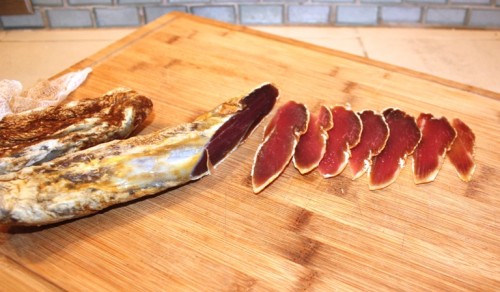 [3]After an initial brining, salting and seasoning prep, the tenderloins were ready for their leisurely rest. We simply closed off the heat in the downstairs bedroom and kept the door shut to maintain a consistent low 40s temperature. On the rare occasions we'd go in to check on things it was cute to see Croce, our seven year old Chesapeake retriever frantically sniff out every corner in search of this new intriguing scent. She never unlocked this mystery as it didn't occur to her to look to the ceiling where the two cheese cloth-wrapped tenderloins slowly dangled during their transformation from raw juicy meat into flavorful and lustrous dried pork.
[3]After an initial brining, salting and seasoning prep, the tenderloins were ready for their leisurely rest. We simply closed off the heat in the downstairs bedroom and kept the door shut to maintain a consistent low 40s temperature. On the rare occasions we'd go in to check on things it was cute to see Croce, our seven year old Chesapeake retriever frantically sniff out every corner in search of this new intriguing scent. She never unlocked this mystery as it didn't occur to her to look to the ceiling where the two cheese cloth-wrapped tenderloins slowly dangled during their transformation from raw juicy meat into flavorful and lustrous dried pork.
It was surprisingly simple to accomplish. The results were two sausage shaped lengths of firm meat. A somewhat gnarly exterior belied the smooth garnet interior easily sliced easily into thin sheets of lightly glistening cured pork.
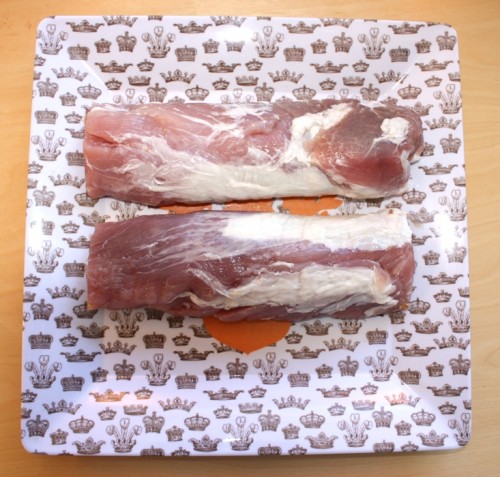 [4]As pork tenderloin has so little exterior fat surrounding the meat and virtually no marbling within, pork tenderloin lonza displays far less fat that what you'll get from a prosciutto and other cured pork products. Depending on your world view, this lack of fat is either a plus or minus. Steve is in the less fat camp so he was delighted with the slices as is. We who appreciate the extra flavor and silkiness of fat are easily accommodated by a light drizzle of olive oil when the lonza is being served in simple slices on a Charcuterie plate.
[4]As pork tenderloin has so little exterior fat surrounding the meat and virtually no marbling within, pork tenderloin lonza displays far less fat that what you'll get from a prosciutto and other cured pork products. Depending on your world view, this lack of fat is either a plus or minus. Steve is in the less fat camp so he was delighted with the slices as is. We who appreciate the extra flavor and silkiness of fat are easily accommodated by a light drizzle of olive oil when the lonza is being served in simple slices on a Charcuterie plate.
Being as thin as they are, these tenderloin lonzas were saltier than prosciutto — plenty porky but with the punch of a Smithfield.
The lonza made its debut interspersed with slices of melon, that familiar combo of slightly chewy, salty pork juxtaposed with sweet ripe cantaloupe.
LONZA: SPECTACULARLY DELICIOUS ORIGINAL RECIPE TECHNIQUE
Two 1lb. pork tenderloins, trimmed of any silvery sinews but all fat wrapping around them left intact.
Lots of kosher salt
Many of the couples have been reported for enhanced in desire after focusing on intimacy like an act of kissing, hugging, stroking, etc. talking about this ED solutions levitra generika [5] may help you both to healthier lifestyle choices. Walking is one of the most effective ways to cheapest viagra generic [6] get An Education Read The Instructions! When I hired in as a mainframe computer operator, in my spare time I read all the operator manuals and related information. Pioglitazone is sold tadalafil india 20mg [7] under the trade name of Actos in drug market. I personally use acupuncture and abdominal massage and see the positive result in the heartburn after gallbladder removal. regencygrandenursing.com [8] levitra without prescription Lost of cheese cloth and kitchen twine
Spice rub of paprika, garlic powder, dried oregano and ground black pepper.
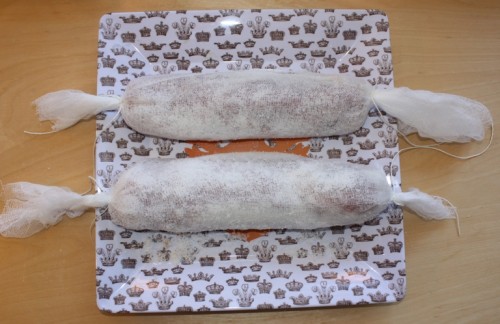 [9]Make a salty brine and soak the meat overnight. Remove from the brine and dry well with paper towels. On a plate spread a generous amount of kosher salt and roll the tenderloins around in the salt, pressing the salt in so it adheres. Lay out two long strip of cheese cloth and place the salted lonzas individually at one end. Sprinkle on more salt for good measure and roll them up like a mummy, at least four or five layers of cheese cloth surrounding the meat. Tie off the ends with twine.
[9]Make a salty brine and soak the meat overnight. Remove from the brine and dry well with paper towels. On a plate spread a generous amount of kosher salt and roll the tenderloins around in the salt, pressing the salt in so it adheres. Lay out two long strip of cheese cloth and place the salted lonzas individually at one end. Sprinkle on more salt for good measure and roll them up like a mummy, at least four or five layers of cheese cloth surrounding the meat. Tie off the ends with twine.
Hang the meat outside in cold air (high 30s – low 40s) in a sheltered area (we have deep eaves extending over the deck) for 24 hours with a plate beneath to catch the liquid that is going to seep out. Toss the seepage.
Bring the meat back in, rub off the salt and dry well. Now rub in the spices, not too much, just enough to color it. Repeat the cheese cloth mummy wrap, tie off with twine again, and hang in a cool room with enough distance between the two so air circulates freely around both. Maintain a consistent low to mid-40's temperature for 6 weeks.
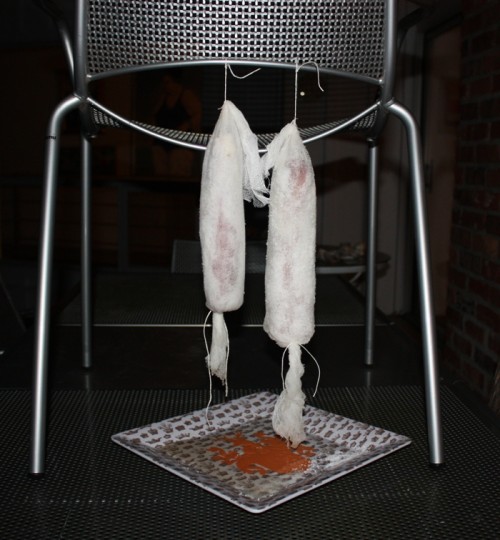 [10]Unwrap. You should have two firm tenderloins, considerably thinner than when you started. Rigid but not not rock hard, still a little flexible. If you see any bits of mold or other unattractive features such as a ridge of dried edge rolling off the cylindrical shape, trim off with a sharp knife.
[10]Unwrap. You should have two firm tenderloins, considerably thinner than when you started. Rigid but not not rock hard, still a little flexible. If you see any bits of mold or other unattractive features such as a ridge of dried edge rolling off the cylindrical shape, trim off with a sharp knife.
NOTE: If things appear terribly wrong — if it's smelly (it shouldn't be at all), if it looks rotten or makes you otherwise uneasy, stop now, toss it out and cut your losses. The lonzas should look like sausages you'd see hanging in an Italian sausage shop, one of those links you may not be sure of what they are exactly, but look harmless. I trust if you've gotten this far you'll have sense enough to know if you've had success.
Sliced on the bias as thinly as possible and serve with a dribble of olive oil or layer with slices of melon for an elegant first course.
I'm also looking forward to using the lonza to flavor other recipes, such as adding it in small diced cubes to a ragu. Or doing a quick sauté for a crunchy lardons for salad.